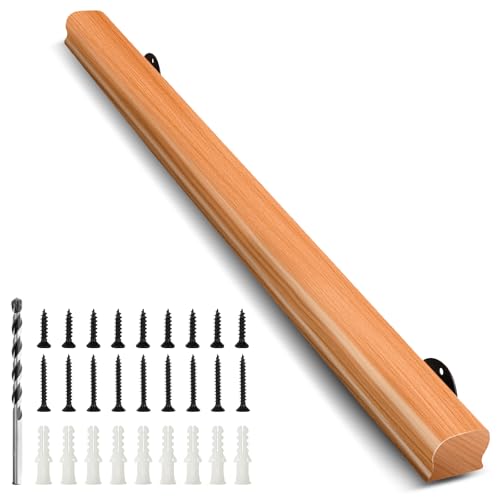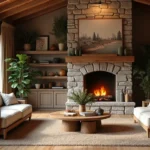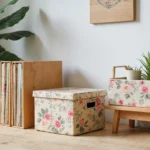When we’re planning a home renovation or building from scratch, stair railings often become an afterthought – but they shouldn’t be. These essential safety features can transform your entire staircase from mundane to magnificent, becoming stunning focal points that reflect your personal style while keeping your family secure.
We’ve discovered that the right railing can completely change how your space feels and functions. Whether you’re drawn to sleek modern glass panels that create an open airy atmosphere, rustic wrought iron that adds character and charm, or contemporary cable systems that blend seamlessly with minimalist design, there’s a perfect solution waiting for your home.
The best part? Today’s railing options offer incredible versatility in materials, styles, and installation methods. From budget-friendly DIY projects to luxurious custom designs, we’ll explore creative ideas that’ll make your stairs the envy of every guest who walks through your door.
Modern Minimalist Stair Railing Ideas for Contemporary Homes
Contemporary homes benefit from clean lines and uncluttered aesthetics that modern minimalist railings provide perfectly. These streamlined designs create visual continuity while maintaining essential safety standards.
Sleek Metal Cable Railings
Cable railings offer the perfect balance of industrial charm and contemporary sophistication. Stainless steel cables stretch horizontally between metal posts, creating an open feel that doesn’t obstruct sightlines. We’ve seen these systems work exceptionally well in lofts, modern townhomes, and open concept spaces where visual flow matters most.
Installation costs typically range from $60 to $120 per linear foot depending on the cable gauge and post material you choose. Aluminum posts provide a lighter aesthetic while steel posts deliver maximum durability for high traffic areas. Many homeowners prefer the 1/8 inch cable diameter for residential applications since it meets most building codes while maintaining that sleek appearance.
Maintenance remains minimal with these systems since cables rarely require adjustment after proper installation. Professional tensioning ensures long lasting performance and prevents sagging over time.
Glass Panel Balustrades
Glass panels create an ultra modern look that maximizes natural light throughout your stairwell. Tempered safety glass panels mount directly to metal or wooden frames without requiring vertical balusters. This design choice works particularly well in homes with scenic views or where you want to showcase architectural details on adjacent walls.
Frameless glass systems cost between $150 to $300 per linear foot while framed options start around $100 per linear foot. Clear glass provides the most minimalist appearance, though frosted or tinted options offer additional privacy for enclosed staircases. We recommend 1/2 inch thick tempered glass for residential installations to ensure proper safety standards.
Cleaning requirements involve weekly glass maintenance using standard glass cleaners and microfiber cloths. Fingerprints and water spots show more readily on glass surfaces compared to other railing materials.
Floating Wooden Handrails
Floating handrails attach directly to the wall without visible brackets for an ultra clean aesthetic. Hidden mounting systems support the handrail from within the wall structure, creating the illusion that the rail hovers independently. Oak, maple, and walnut species work best for these installations due to their strength and grain patterns.
Professional installation costs range from $40 to $80 per linear foot including the hidden bracket system and wall reinforcement. Custom millwork shops can create curved floating rails for spiral or curved staircases, though these specialty pieces increase costs by 50 to 100 percent.
Wall anchoring requires structural support since these railings rely entirely on wall mounted hardware. Proper installation into wall studs or blocking ensures the rail can support the required 200 pound load per building codes.
Traditional Wooden Stair Railing Ideas That Never Go Out of Style
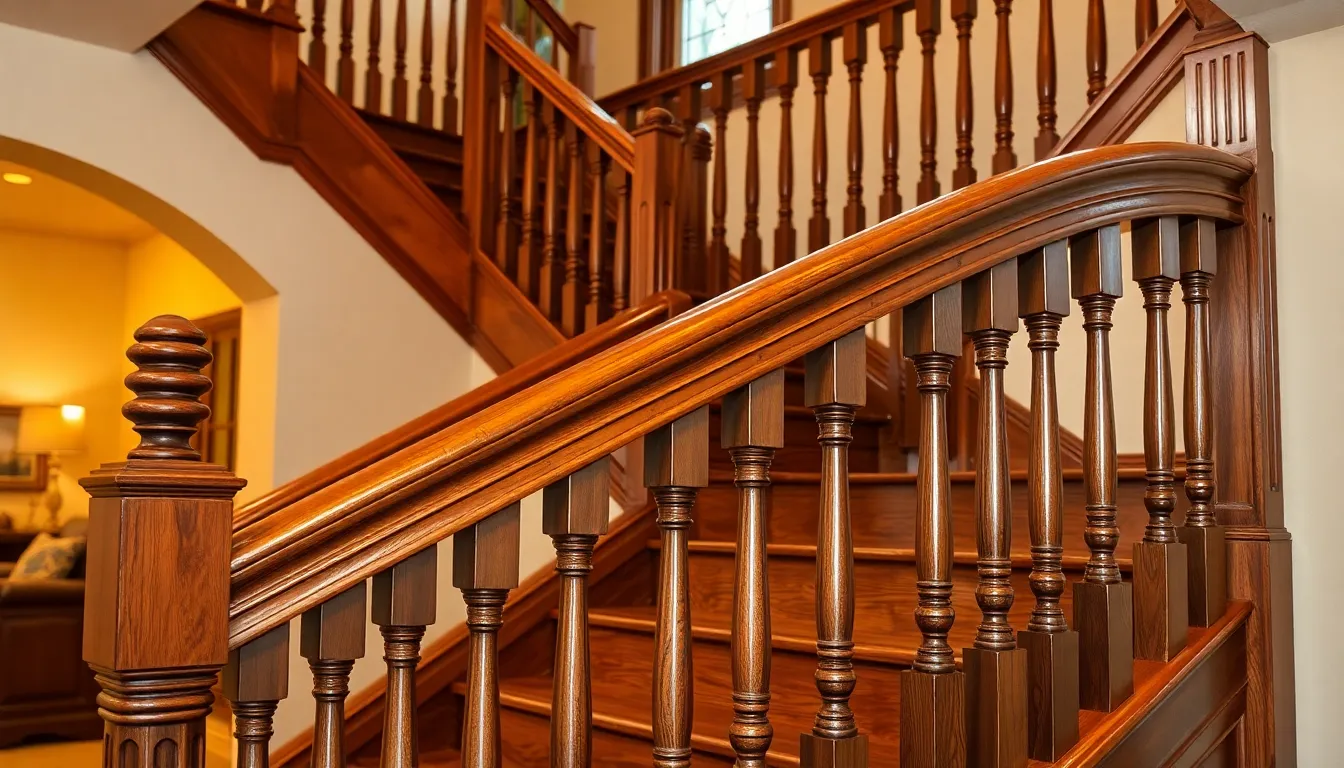
Traditional wooden railings offer timeless appeal that complements architectural styles from Victorian homes to modern spaces seeking heritage touches.
Classic Spindle and Newel Post Designs
Classic spindle configurations create the foundation of traditional staircase design with their quintessential structural elements. Solid wood spindles provide uniform aesthetic appeal while maintaining the essential safety function of stair railings. Sturdy newel posts anchor these designs with both structural support and visual prominence that defines the staircase character.
Ornate newel posts showcase intricate woodworking craftsmanship that becomes a focal point of the entire stairway. Simple newel post designs offer understated elegance that lets the overall staircase design take center stage. Uniform spindle patterns create visual rhythm and consistency that guides the eye naturally along the staircase path.
Carved Balusters with Rich Wood Stains
Carved balusters elevate traditional railings with intricate artistic details that showcase exceptional craftsmanship. Scrollwork patterns add flowing elegance to wooden balusters that transform functional elements into decorative artwork. Floral carved designs bring natural beauty to stair railings while maintaining the structural integrity needed for safety.
Rich mahogany stains enhance the natural wood grain with deep, warm tones that create luxurious visual appeal. Walnut finishes provide classic elegance with their distinctive color variations that highlight the carved details beautifully. These premium wood stains protect the carved elements while intensifying the natural beauty of the wooden balusters.
Mission Style Railings
Mission style railings emphasize clean lines and minimal ornamentation that reflect early 20th century design principles. Horizontal line emphasis creates visual stability while flat surface treatments maintain the style’s characteristic simplicity. Rectangular handrails complement the robust structural approach that defines this architectural movement.
Solid wood construction ensures durability while supporting the Mission style’s focus on honest materials and functional design. Sturdy rectangular profiles provide comfortable grip surfaces that prioritize user safety without sacrificing aesthetic integrity. These railings integrate seamlessly with various home styles while maintaining their distinctive design heritage.
Industrial Stair Railing Ideas for Urban Loft Aesthetics
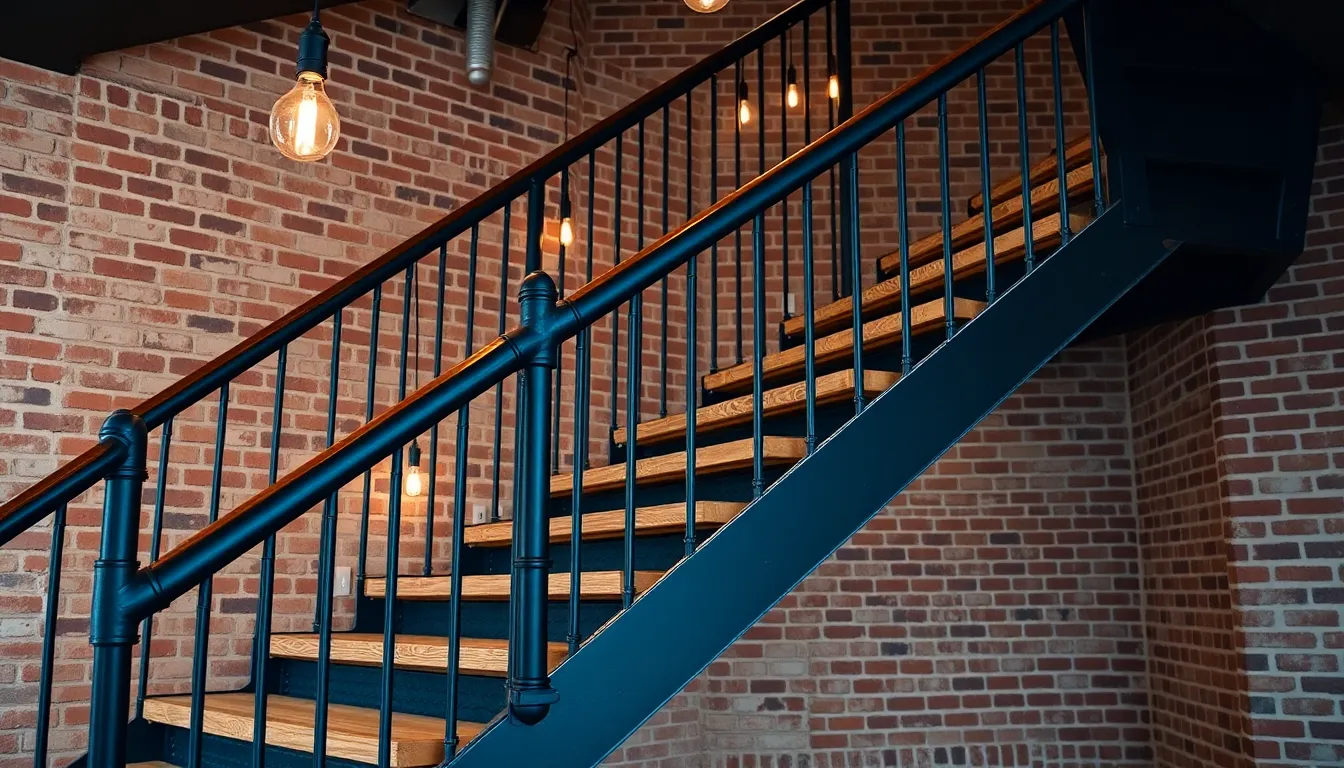
Industrial stair railings perfectly capture the raw, authentic feel that makes urban lofts so appealing. These designs emphasize functionality while delivering striking visual impact through exposed materials and bold structural elements.
Black Iron Pipe Railings
Black iron pipe railings offer the most versatile approach to industrial stair design with their robust minimalist appearance. We’ve seen these railings transform simple staircases into architectural focal points through configurations ranging from basic horizontal runs to intricate geometric patterns.
Materials and Construction: Steel pipes and fittings form the foundation of these durable railing systems. The black iron finish provides both protection against corrosion and the authentic industrial look that urban loft owners desire.
Installation Benefits: DIY friendly installation makes black iron pipe railings accessible to homeowners and contractors alike. Customization options allow you to fit these railings to any staircase configuration while maintaining their distinctive industrial character.
Raw Steel and Reclaimed Wood Combinations
Raw steel paired with reclaimed wood creates the perfect marriage between industrial strength and rustic warmth. This combination emphasizes natural textures while adding vintage charm to otherwise stark industrial spaces.
Material Integration: Structural strength comes from the raw steel framework while reclaimed wood elements soften the overall aesthetic. The contrast between these materials highlights both the rugged industrial elements and the organic beauty of aged wood.
Professional Installation: Careful planning ensures seamless integration between steel and wood components. Most installations require professional expertise to achieve the proper balance and structural integrity that these hybrid designs demand.
Exposed Metal with Edison Bulb Lighting
Exposed metal railings paired with Edison bulb lighting create dramatic visual effects that enhance any industrial staircase. The sleek metal lines complement the vintage appeal of Edison bulbs while adding warm nostalgic ambiance to urban loft spaces.
Design Elements: Steel or aluminum construction provides the structural framework while Edison bulbs add character lighting. This combination highlights the metalwork details and creates stunning shadow patterns on surrounding walls.
Installation Considerations: Safety and aesthetic planning go hand in hand with these lighting integrated designs. Proper electrical work ensures both functionality and visual impact while meeting building code requirements for stair lighting.
Creative DIY Stair Railing Ideas on a Budget

Budget friendly stair railing projects let us transform our staircases without very costly. We can achieve stunning results using simple construction techniques and inexpensive materials.
Rope and Wood Nautical Themes
Combining wood with marine rope creates a durable and stylish nautical look that brings seaside charm indoors. We can pair wooden rails or balusters with thick, weather resistant rope either threaded through balusters or used as horizontal railing supports. This approach delivers a coastal inspired design that works beautifully in beach houses, lake cottages, or any home where we want to evoke maritime memories.
Wooden posts serve as anchor points while the rope provides both safety and visual interest between them. We should choose marine grade rope that resists moisture and maintains its appearance over time. Threading the rope through drilled holes in wooden balusters creates clean lines, while wrapping it around posts adds texture and authentic nautical character.
Repurposed Materials and Upcycled Elements
Reusing old pipes, metal rods, reclaimed wood, or salvaged architectural pieces gives stair railings unique, eco friendly character while reducing costs significantly. We can transform discarded materials into stunning design elements that tell a story and reduce environmental impact. Metal pipes cleaned and painted can serve as stylish balusters, while reclaimed wood sanded and sealed works perfectly for handrails or panels.
Salvaged architectural pieces like old porch spindles or decorative ironwork add instant vintage charm to our staircase projects. We should inspect all repurposed materials for structural integrity before installation. Local salvage yards, construction sites, and online marketplaces often provide excellent sources for these budget friendly materials.
Branch and Twig Natural Designs
Utilizing natural branches or twigs creates rustic or organic stair railings that bring the outdoors inside. We can clean branches, strip bark, and attach them directly between posts or weave them together with wire or twine for natural appeal. This approach proves especially effective for cabins, cottages, or homes embracing rustic aesthetics.
Collecting branches from our own property or local areas keeps costs minimal while ensuring we get exactly the shapes and sizes needed. We should select sturdy branches that can support weight and meet safety requirements. Proper preparation includes removing all bark, sanding rough spots, and applying clear sealers to preserve the natural wood and prevent insect damage.
Luxury Stair Railing Ideas for High-End Homes

Elevating your staircase with premium materials and sophisticated designs transforms it into a stunning architectural focal point. We’ve curated these luxury railing concepts that showcase exceptional craftsmanship and timeless elegance.
Wrought Iron Artistic Scrollwork
Wrought iron artistic scrollwork offers unparalleled versatility and creative potential for discerning homeowners. This premium material allows artisans to create intricate patterns that seamlessly blend traditional elegance with contemporary sophistication. Each scrollwork design becomes a unique masterpiece, featuring flowing curves and detailed motifs that capture light beautifully throughout the day.
We’ve observed how custom scrollwork patterns can reflect personal style while maintaining structural integrity. These handcrafted elements work exceptionally well in grand foyers and curved staircases, where their artistic details can be fully appreciated. The durability of wrought iron ensures your investment maintains its beauty for decades with minimal maintenance.
Marble and Brass Combinations
Marble and brass combinations create striking visual contrasts that define luxury stair design. We appreciate how the sleek marble surfaces provide an elegant foundation while warm brass accents add sophisticated metallic highlights. This pairing works particularly well in contemporary estates where clean lines meet opulent materials.
Brass handrails complement marble balusters beautifully, creating a tactile experience that’s both functional and visually stunning. The natural veining in marble ensures each installation remains completely unique. We recommend incorporating brass elements through both handrails and decorative baluster caps to achieve cohesive luxury aesthetics.
Custom Forged Metal Designs
Custom forged metal designs unlock endless creative possibilities for personalized stair railings. We’ve seen homeowners commission everything from sleek geometric patterns to elaborate nature inspired motifs. This approach allows complete customization to match existing architectural elements and interior design themes.
Modern forging techniques enable artisans to create both minimalist linear designs and ornate traditional patterns. Each custom piece reflects the homeowner’s individual style while providing exceptional structural support. We particularly admire how electroplated metallic finishes in gold or silver enhance the luxury appeal of these bespoke installations.
| Luxury Railing Feature | Material Combination | Typical Installation Cost Range |
|---|---|---|
| Wrought Iron Scrollwork | Iron with custom finishes | $150-300 per linear foot |
| Marble and Brass | Natural stone with brass accents | $200-400 per linear foot |
| Custom Forged Metal | Steel with electroplated finishes | $175-350 per linear foot |
Space-Saving Stair Railing Ideas for Small Homes
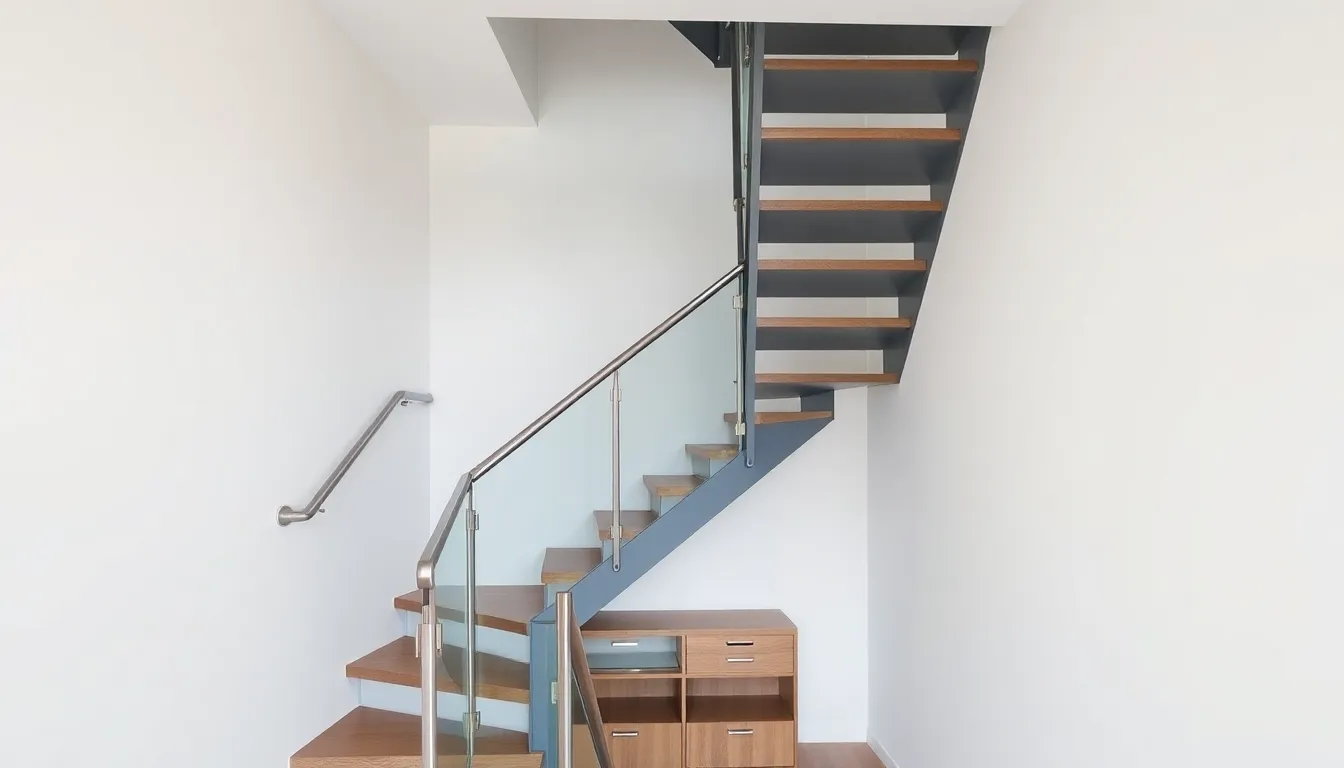
Small homes demand creative answers that maximize both functionality and visual openness. Minimalist railings with clean lines and transparent materials help reduce visual clutter while making spaces appear larger.
Wall-Mounted Handrail Systems
Wall-mounted handrail systems eliminate the need for bulky posts or balusters, freeing up valuable floor space in compact areas. These systems typically feature slim metal or wood profiles that attach directly to the wall, providing essential support without encroaching on the staircase footprint. Sleek designs work exceptionally well in tiny houses or studios where every inch counts, as they maintain safety standards while preserving an open feel.
Installation proves straightforward since these systems require fewer components than traditional railings. Metal profiles offer durability and modern appeal, while wood options provide warmth and complement various interior styles. Custom configurations adapt to unique wall angles or irregular spaces, ensuring a perfect fit for challenging layouts.
Integrated Storage Answers
Under-stair storage transforms otherwise wasted areas into functional space by incorporating built-in compartments, drawers, or closets beneath the staircase. Railings can complement these storage elements or even integrate shelving directly into the handrail system itself. This dual-purpose approach enhances both functionality and style while maximizing every square foot of available space.
Built-in answers include pull-out drawers for seasonal items, open shelving for books or decor, and closed compartments for household supplies. Coordinating the railing design with storage elements creates a cohesive look that appears intentional rather than added as an afterthought. We recommend planning both elements together during the design phase to achieve optimal integration.
Compact Spiral Stair Railings
Spiral staircases rank among the most space-efficient options for connecting levels in small homes, requiring significantly less square footage than traditional straight or L-shaped stairs. Railings for spiral stairs follow the curve of the steps while maintaining safety standards and preserving open sightlines throughout the space. Materials like metal, wood, or glass can be crafted into minimalist or custom designs that match the home’s existing decor.
Curved railings present unique installation challenges but offer dramatic visual impact in compact spaces. Glass panels work particularly well with spiral designs, as they maintain transparency while providing necessary safety barriers. Metal railings offer structural strength and can be powder-coated in various colors to complement the overall design scheme.
Outdoor Stair Railing Ideas for Porches and Decks
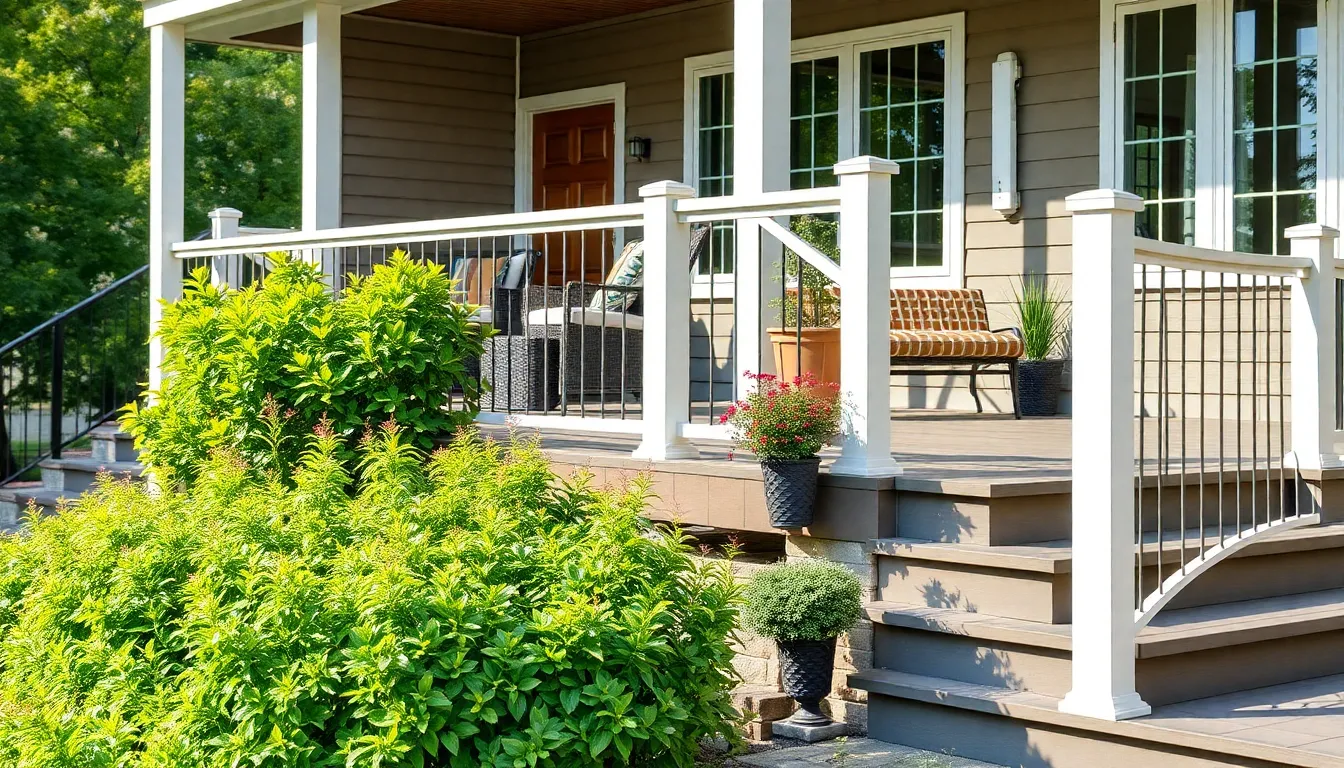
Outdoor stair railings face unique challenges that require materials capable of withstanding weather extremes while maintaining aesthetic appeal. We’ll explore durable options that combine practical performance with visual impact for your exterior spaces.
Weather-Resistant Composite Materials
Composite decking materials offer exceptional durability for outdoor stair railings, combining wood fibers with plastic polymers to create maintenance-free answers. These innovative materials resist rot, mold, and insect damage, eliminating the constant upkeep required by traditional wood railings. We’ve seen composite railings maintain their appearance for over 20 years without staining, sealing, or painting.
Benefits of composite materials include resistance to moisture absorption, which prevents warping and cracking during freeze-thaw cycles. Color consistency remains stable throughout the material, so scratches and wear don’t reveal different tones underneath. Installation proves straightforward with standard woodworking tools, while the material’s flexibility allows for curved or angled configurations.
Decorative Metal with Powder Coating
Metal railings crafted from aluminum, steel, or wrought iron provide sleek modern aesthetics while delivering superior structural strength. Powder coating technology creates a durable finish that resists corrosion, scratches, and UV damage more effectively than traditional paint applications. We recommend powder coated finishes because they’re available in hundreds of colors and can match any exterior décor scheme.
Aluminum railings offer lightweight installation with rust-free performance, making them ideal for coastal environments. Steel options provide maximum strength for high-traffic areas, while wrought iron delivers classic elegance with intricate design possibilities. Maintenance requirements remain minimal with occasional cleaning using mild soap and water.
Natural Stone and Concrete Options
Stone railings incorporate natural materials like granite, limestone, or marble to create luxurious outdoor features that improve with age. These materials withstand extreme weather conditions while developing attractive patina over time. We’ve observed stone railings lasting decades with minimal maintenance beyond periodic cleaning.
Concrete railings can be molded into various shapes and designs, offering unlimited customization possibilities at affordable prices. Modern concrete techniques allow for textures that mimic wood, stone, or other materials while providing superior durability. Precast concrete options reduce installation time, while poured-in-place systems accommodate complex architectural requirements.
| Material Type | Average Cost per Linear Foot | Maintenance Level | Lifespan |
|---|---|---|---|
| Composite | $25-45 | Low | 20-25 years |
| Powder Coated Metal | $30-60 | Very Low | 25-30 years |
| Natural Stone | $50-100 | Low | 50+ years |
| Concrete | $20-40 | Low | 30-40 years |
Safety-First Stair Railing Ideas for Families with Children
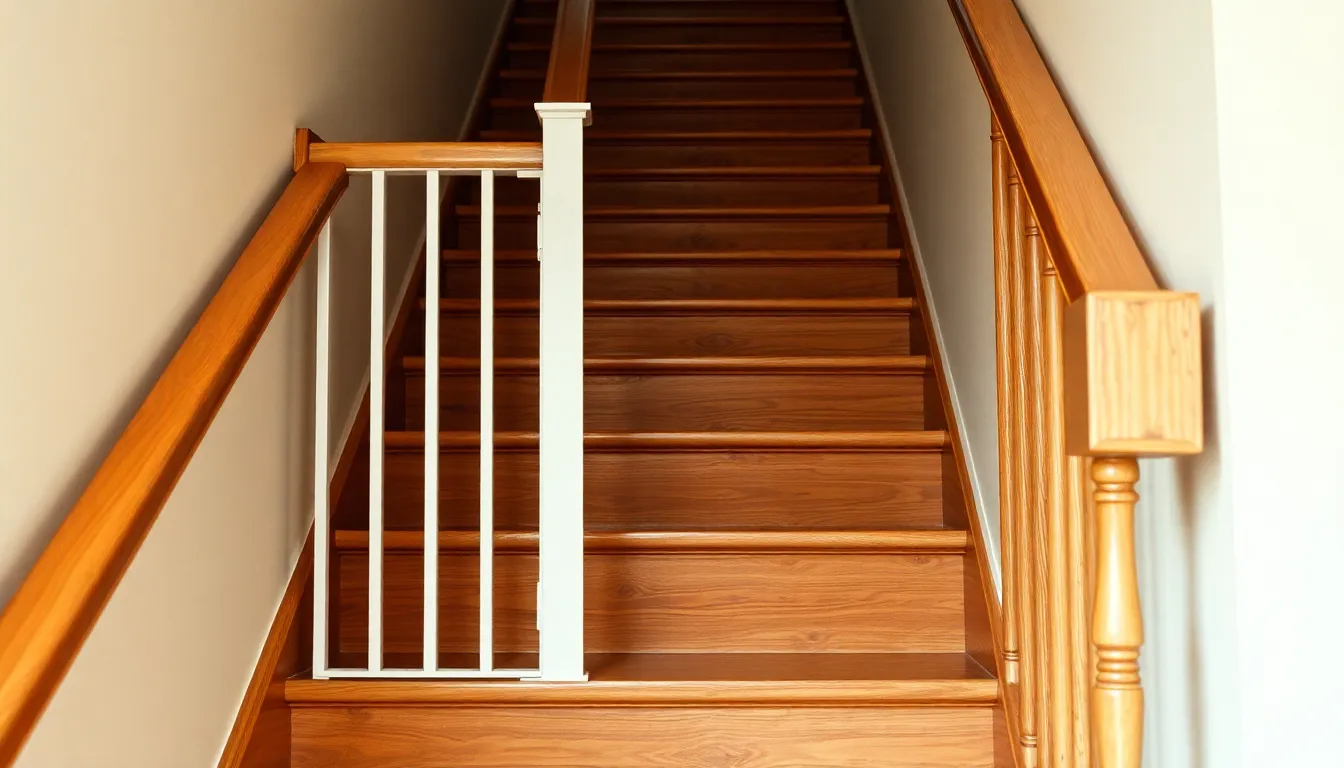
When families with young children consider stair railing renovations, safety becomes the top priority alongside aesthetic appeal. Parents need railing answers that effectively prevent accidents while maintaining the home’s design integrity.
Child-Proof Locking Mechanisms
Metal safety gates provide the strongest foundation for child protection on staircases. These durable barriers feature secure locking mechanisms that prevent children from accessing stairs without adult assistance. Installation requires gates to be firmly anchored to both walls or railings for maximum stability.
Banister guards offer an elegant solution for closing dangerous gaps in existing railings. Clear plastic or mesh panels attach directly to current railings, preventing children from squeezing through openings while maintaining visibility. These guards blend seamlessly with most railing designs without compromising the staircase’s visual appeal.
Vertical spindle installations reduce gap widths in horizontal railing systems significantly. Installing additional vertical supports between existing rails creates smaller openings that children cannot navigate through. This modification works particularly well with traditional wooden railings and modern metal designs.
Optimal Height and Spacing Requirements
Stair gate height specifications require a minimum of 29 inches to prevent children from climbing over barriers. Gates with bars spaced no more than 3 inches apart eliminate climbing opportunities and prevent entrapment incidents. Professional installation ensures proper measurements and secure mounting for optimal safety.
Railing gap standards mandate spacing of no more than 4 inches between spindles or balusters. This measurement prevents children from slipping through openings while allowing adequate airflow and visibility. Existing railings often need modification to meet these safety requirements.
| Safety Feature | Required Measurement | Safety Benefit |
|---|---|---|
| Gate Height | Minimum 29 inches | Prevents climbing over |
| Bar Spacing | Maximum 3 inches | Eliminates climbing/entrapment |
| Railing Gaps | Maximum 4 inches | Prevents slip-through accidents |
Handrail height positioning should accommodate both adult and child use effectively. Standard handrails at 34-38 inches work for adults, while secondary rails at 24-28 inches provide support for children learning to navigate stairs safely.
Non-Slip Handrail Materials
Textured wood surfaces deliver superior grip security for all family members. Natural wood grain provides inherent texture, while sanded finishes with light texturing enhance grip without creating splinter risks. Regular maintenance with appropriate wood sealers preserves both safety and appearance.
Rubber and vinyl coatings create non-slip surfaces ideal for high-moisture areas and frequent use zones. These materials apply over existing handrails, providing immediate grip improvement without complete railing replacement. Cleaning requires only mild soap and water for maintenance.
Anti-slip tape applications enhance traction on stair treads and handrail surfaces effectively. Applying tape to stair steps reduces slip hazards, especially in areas prone to moisture accumulation. Clear tape options maintain the original appearance while improving safety performance.
Cushioned edge guards soften hard corners and edges throughout the railing system. These protective covers attach to newel posts, handrail ends, and sharp corners to mitigate injury risks during falls or collisions. Available in various colors, they integrate with existing decor while providing essential protection.
Conclusion
Choosing the perfect stair railing transforms your home’s aesthetic while ensuring safety and functionality. We’ve explored options that suit every style preference and budget from sleek modern designs to timeless traditional craftsmanship.
Whether you’re drawn to industrial metal pipes luxury wrought iron or budget-friendly DIY answers the key lies in matching your railing choice to your home’s architecture and your family’s needs. Outdoor spaces require weather-resistant materials while homes with children benefit from specialized safety features.
Your staircase deserves a railing that reflects your personal style and enhances your daily living experience. With proper planning and the right materials you’ll create a stunning focal point that adds both value and character to your home for years to come.
Frequently Asked Questions
What are the main benefits of upgrading stair railings during home renovation?
Stair railings serve dual purposes: essential safety features and striking design elements. They enhance your home’s overall aesthetic while providing crucial support and fall prevention. Modern railing options can transform ordinary staircases into architectural focal points, increasing both functionality and property value while complementing various design styles from contemporary to traditional.
How much do modern minimalist stair railings typically cost?
Modern minimalist railings vary in price depending on materials. Cable railings range from $60-120 per linear foot, while glass panel systems cost $150-300 per linear foot. Floating wooden handrails are more budget-friendly at $40-80 per linear foot. Installation costs add $50-100 per linear foot, making total project costs range from $500-2,000 for average staircases.
What makes glass panel railings a popular choice for contemporary homes?
Glass panel railings maximize natural light flow and create unobstructed views, making spaces appear larger and more open. They offer sleek, modern aesthetics that complement contemporary architecture while requiring minimal maintenance. The transparent design doesn’t visually clutter spaces, and tempered safety glass ensures durability and meets building codes for residential applications.
Are traditional wooden railings suitable for modern homes?
Yes, traditional wooden railings offer timeless versatility that complements both classic and modern architectural styles. They can be customized with various wood species, stains, and finishes to match contemporary design preferences. Classic spindle designs and carved balusters add character while maintaining clean lines that work well in modern settings when properly styled.
What are the most durable outdoor stair railing materials?
Weather-resistant composite materials, powder-coated metal, and natural stone offer superior durability for outdoor applications. Composite railings combine wood fibers with plastic polymers for maintenance-free longevity. Powder-coated aluminum and steel resist corrosion and scratches. Natural stone and concrete provide exceptional weather resistance with minimal upkeep requirements, lasting 20-50 years.
How can I make stair railings child-safe without compromising design?
Install child-proof safety gates with locking mechanisms, ensure railing heights meet 36-42 inch requirements, and maintain 4-inch maximum spacing between balusters. Use non-slip handrail materials and add cushioned edge guards to soften sharp corners. Choose smooth finishes without decorative elements that children could climb, while selecting stylish safety features that complement your home’s aesthetic.
What are some budget-friendly DIY stair railing ideas?
Combine reclaimed wood with marine rope for nautical themes, repurpose galvanized pipes with wood accents for industrial looks, or use natural branches for rustic aesthetics. These DIY projects typically cost $100-400 compared to $1,000+ for professional installations. Simple construction techniques using basic tools make these projects accessible for most homeowners while creating unique, personalized designs.
When should I hire professionals versus attempting DIY railing installation?
Hire professionals for complex installations involving glass panels, intricate metalwork, or structural modifications. DIY is suitable for simple wooden railings, rope systems, or basic pipe installations when you have construction experience. Consider local building codes, safety requirements, and your skill level. Professional installation ensures code compliance and structural integrity, especially for luxury materials or challenging layouts.








